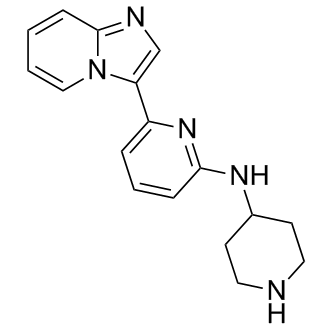| Cas No.: | 1042224-63-4 |
| Synonyms: | 2-Pyridinamine, 6-imidazo[1,2-a]pyridin-3-yl-N-4-piperidinyl- |
| SMILES: | C1(C2=CN=C3N2C=CC=C3)=CC=CC(NC4CCNCC4)=N1 |
| Formula: | C17H19N5 |
| M.Wt: | 293.3663 |
| Purity: | >98% |
| Sotrage: | 2 years -20°C Powder, 2 weeks 4°C in DMSO, 6 months -80°C in DMSO |
| Description: | IRAK inhibitor 1 is a potent IRAK-4 inhibitor with IC50 of 216 nM, is poorly active against JNK-1 and JNK-2 with IC50 of 3.801 μM, and >10 μM, respectively. |
| Target: | IC50: 216 nM (IRAK-4), 3.801 μM (JNK-1), >10 μM (JNK-2)[1] |
| In Vitro: | IRAK inhibitor 1 possesses significant potency in an IRAK-4 enzyme assay but is poorly active against JNK-1 and JNK-2[1]. IRAK-4 is a novel member of the IRAK family with unique functional properties. IRAK-4 is the closest human homolog to Pelle. Endogenous IRAK-4 interacts with IRAK-1 and TRAF6 in an IL-1-dependent manner, and overexpression of IRAK-4 can activate NF-κB as well as mitogen-activated protein (MAP) kinase pathways. Most strikingly, and in contrast to the other IRAKs, IRAK-4 depends on its kinase activity to activate NF-κB. In addition, IRAK-4 is able to phosphorylate IRAK-1, and overexpression of dominant-negative IRAK-4 is blocking the IL-1-induced activation and modification of IRAK-1, suggesting a role of IRAK-4 as a central element in the early signal transduction of Toll/IL-1 receptors, upstream of IRAK-1. IRAK-4 shares the domain structure of the other IRAKs and it is able to activate similar signal transduction pathways, namely NF-κB and MAPK pathways. It rapidly and transiently associates with IRAK-1 and TRAF6 in an IL-1-dependent manner but it is not functionally redundant with IRAK-1. IRAK-4 is an active protein kinase and requires its kinase activity to activate NF-κB. IRAK-4 might act upstream of IRAK-1 as an IRAK-1 activator[2]. |
| References: | [1]. Buckley GM, et al. IRAK-4 inhibitors. Part II: A structure-based assessment of imidazo[1,2-a]pyridine binding. Bioorg Med Chem Lett. 2008 Jun 1;18(11):3291-5. [2]. Li S, et al. IRAK-4: a novel member of the IRAK family with the properties of an IRAK-kinase. Proc Natl Acad Sci U S A. 2002 Apr 16;99(8):5567-72. |

 DC Chemicals' products qualify for U.S. tariff exemptions. We guarantee no price increases due to customs duties and maintain stable supply, continuing to deliver reliable research solutions to our American clients.
DC Chemicals' products qualify for U.S. tariff exemptions. We guarantee no price increases due to customs duties and maintain stable supply, continuing to deliver reliable research solutions to our American clients.





















